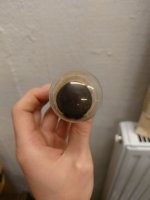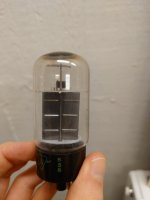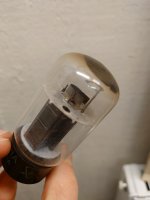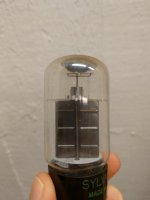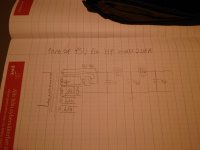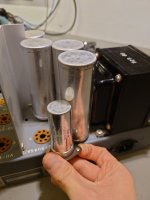Just got the guts off a scrapped AF frequency generator made by HP, model 206A. It's way way gone but the tubes, sockets and PSU seem to be intact. I've been thinking of making my own tube PSU but now this one is just right here, was wondering if the PSU might be worth keeping as is for a DIY amp or if I should just grab the transformer, chokes and diode and making my own thing with it?
It has some 6L6 GB tubes(couldn't find any picture of the GB variant online so I've attached some 🙂 I think it's quite nice looking!) and a OD3 after the filter but I don't think I'd want to keep that part, seems like a waste of 6L6s to me. I'd rather use those for output tubes 🙂
Attached a sketch of the part of the PSU I'd be interested in keeping. I don't know what voltage the output would be though but if i finish salvaging/scrapping the rest I could potentially turn it on and find out. A bit worried about the caps, not sure if they are electrolytic or some other type. They are very large for being 4uF electrolytics even for 600V rated caps, but my references are more modern capacitors.
It has some 6L6 GB tubes(couldn't find any picture of the GB variant online so I've attached some 🙂 I think it's quite nice looking!) and a OD3 after the filter but I don't think I'd want to keep that part, seems like a waste of 6L6s to me. I'd rather use those for output tubes 🙂
Attached a sketch of the part of the PSU I'd be interested in keeping. I don't know what voltage the output would be though but if i finish salvaging/scrapping the rest I could potentially turn it on and find out. A bit worried about the caps, not sure if they are electrolytic or some other type. They are very large for being 4uF electrolytics even for 600V rated caps, but my references are more modern capacitors.
Attachments
The manual indicates that the power transformer has a 520-0-520V HV secondary. Be careful, that's a lot of voltage.
Where did you find the manual? I was only able to find a circuit diagram and some general info.The manual indicates that the power transformer has a 520-0-520V HV secondary. Be careful, that's a lot of voltage.
And that is definitely a lot of voltage, I was expecting more like 250V because of the 150V reference in the PSU, that's also way above the max rating of the PSU capacitors. They are all rated 600VDC whilst some other caps in the circuit are rated 450V(not specified AC or DC)
First hit on Google: http://hparchive.com/Manuals/HP-206A-Manual.pdf
Schematic at page 35.
Quite weird power supply, they seem to waste almost 300V in the regulator circuit.
Schematic at page 35.
Quite weird power supply, they seem to waste almost 300V in the regulator circuit.
I thought so at first but I have never seen a round oil cap, they are always very nice looking boxes in my experience. The 450V rated 40uF capacitor that's also in the circuit is not even half the size though...Perhaps they are oil filled capacitors, not 'lytic.
edit
Manual says they are paper caps! So they are not electrolytics but polar paper caps! Mystery solved 😄
Thank you! Not sure why I didn't find that one. The schematic is both much higher quality and more correct than the one I was working with. Nice to see that the transformer is easy to rewire to 230V too! Not that I have a use for the voltage I'd get out of that transformer right now 😅First hit on Google: http://hparchive.com/Manuals/HP-206A-Manual.pdf
Schematic at page 35.
Quite weird power supply, they seem to waste almost 300V in the regulator circuit.
Attachments
You're welcome. I got curious and dug up the schematic to see if it had the same power transformer as the one I took from an old HP distortion analyzer and used in a guitar amp last year.
Yeah, I'll tear down this PSU, the caps might be re used in a similar PSU but with a different transformer or I'll swap them. The chokes will definitely get reused for another PSU, haven't had any good shielded inductors to use for PSUs before so that will be niceIf you are thinking to reuse them, check capacitance and leackage.
Take into account that a choke is usually specifically designed for a specific job. Core size, turn number, gap, AC voltage, wire size, DC current, fiirst element or second in the filter, etc.
Not any choke will perform ok in any circuit.
Not any choke will perform ok in any circuit.
Definitely something I'll keep in mind, I plan on using them in a very similar application though. They are most likely going to be run with the same diode, but at a lower voltage and probably around the same amount of current.Take into account that a choke is usually specifically designed for a specific job. Core size, turn number, gap, AC voltage, wire size, DC current, fiirst element or second in the filter, etc.
Not any choke will perform ok in any circuit.
Going to play around in simulation and see if I can get acceptable results using just one of them though, that way I can have two good tube rectified PSUs 🙂 maybe make the caps a bit bigger, I'll have to look at what the diodes I want to use can take.
Imho it could be in your educational interests to not gut that just yet. There is typically a lot to gain by making yourself aware of what you have first, and to think carefully about what you want to achieve and whether the existing circuit or a slight modification can get you want you want.
For starters, it is often less risky to restore what you have for starters, as then you end up knowing what works (and can continue to be used) and what has degraded. Perhaps you've never gone down the restoration path before, or have the tools to check certain parts, but imho that is what is needed, even if you think you can just harvest a few parts. If you aren't in a position to safely test parts, then harvesting parts from old equipment (rather than purchasing new) is quite an electrical risk.
The 240V regulated supply is the main aim of a quality instrument like the 206A. Having a regulated voltage of that level, as well as an unregulated higher B+, was the mainstay of quality vintage pentode-mode audio amps that needed a stiff screen supply - that is how a lot of the datasheet values for distortion were derived for audio output stage valves.
The output stage of the 206A also has nice audio amplifier, and a 15 ohm speaker could be used across the 50 to 150 ohm tappings if that section of the instrument was still in ok condition.
The power transformer T1 appears to have 5v @ 3A, 6.3v @ 1A, 3.15/6.3v @ 5A, 6.3v @ 2.5A, and 460/920v @ 125mA. You would need to assess that with any aim for using in an amp - especially the 125mA rating of the HT.
For starters, it is often less risky to restore what you have for starters, as then you end up knowing what works (and can continue to be used) and what has degraded. Perhaps you've never gone down the restoration path before, or have the tools to check certain parts, but imho that is what is needed, even if you think you can just harvest a few parts. If you aren't in a position to safely test parts, then harvesting parts from old equipment (rather than purchasing new) is quite an electrical risk.
The 240V regulated supply is the main aim of a quality instrument like the 206A. Having a regulated voltage of that level, as well as an unregulated higher B+, was the mainstay of quality vintage pentode-mode audio amps that needed a stiff screen supply - that is how a lot of the datasheet values for distortion were derived for audio output stage valves.
The output stage of the 206A also has nice audio amplifier, and a 15 ohm speaker could be used across the 50 to 150 ohm tappings if that section of the instrument was still in ok condition.
The power transformer T1 appears to have 5v @ 3A, 6.3v @ 1A, 3.15/6.3v @ 5A, 6.3v @ 2.5A, and 460/920v @ 125mA. You would need to assess that with any aim for using in an amp - especially the 125mA rating of the HT.
It's definitely impossible to restore this instrument, I just got most of the guts and the only part that had mostly intact wiring was the PSU section. The OPT was tossed as it was starting to fall apart apparently and the case has been reclaimed for another project by the person I got the guts from. I belive there are some adjustable caps in the circuit too, don't have those either. I just have the steel box with the tubes and sockets and most of the wiring between the tubes, even that was hacked away to get it out of there and only the PSU seemed to have minimal wires missing, therefore my OP 🙂Imho it could be in your educational interests to not gut that just yet. There is typically a lot to gain by making yourself aware of what you have first, and to think carefully about what you want to achieve and whether the existing circuit or a slight modification can get you want you want.
For starters, it is often less risky to restore what you have for starters, as then you end up knowing what works (and can continue to be used) and what has degraded. Perhaps you've never gone down the restoration path before, or have the tools to check certain parts, but imho that is what is needed, even if you think you can just harvest a few parts. If you aren't in a position to safely test parts, then harvesting parts from old equipment (rather than purchasing new) is quite an electrical risk.
The 240V regulated supply is the main aim of a quality instrument like the 206A. Having a regulated voltage of that level, as well as an unregulated higher B+, was the mainstay of quality vintage pentode-mode audio amps that needed a stiff screen supply - that is how a lot of the datasheet values for distortion were derived for audio output stage valves.
The output stage of the 206A also has nice audio amplifier, and a 15 ohm speaker could be used across the 50 to 150 ohm tappings if that section of the instrument was still in ok condition.
The power transformer T1 appears to have 5v @ 3A, 6.3v @ 1A, 3.15/6.3v @ 5A, 6.3v @ 2.5A, and 460/920v @ 125mA. You would need to assess that with any aim for using in an amp - especially the 125mA rating of the HT.
I have the means to test pretty much everything you can think of electrically so characterising what I pick out and sering if it's in good condition or not should be no problem. I'll only be grabbing the inductors, caps, tubes and sockets. The only thing I am really missing would be a tube tester, the glass tubes look to be in good shape, I'd expect them to work as long as the heaters are alright. The metal ones I'd have to take a gamble on or build something to test them with, they don't sound like maracas at least 😃
- Home
- Amplifiers
- Tubes / Valves
- Scrap or use old tube PSU?

